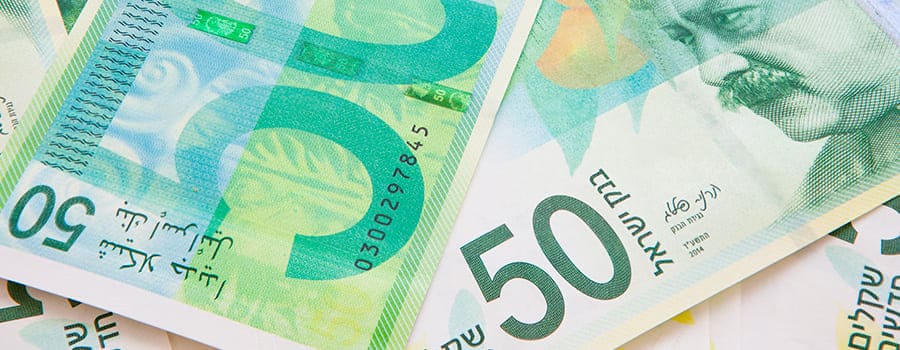Given the success of the Israeli vaccination programme, the country’s economy is likely to recover faster than that of most eurozone countries. The question then becomes, could this lead to an excessive appreciation of the shekel? In the wake of recent Israeli parliamentary elections, we take a look at ongoing developments in the EUR/ILS pair.
Euro/shekel (EUR/ILS) fluctuations in recent times can be viewed cyclically. Since the pair reached an all-time high of 5.95 just before the outbreak of the 2007 financial crisis, it has entered a long-term bearish cycle. This trend was only consolidated by the Covid-19 crisis. In the space of a year, the EUR/ILS has shed almost 2.5% of its value and is now hovering around the 3.90 mark. Projected over three years, the decline is even greater, at around 8%, and almost 10% over five years.
Since the beginning of the current crisis, the Israeli central bank has implemented a series of measures that aim, among other things, to lower the shekel’s exchange rate against the euro and the US dollar. These measures include the reduction of the key interest rate to an all-time low of 0.1% and the launch of an asset purchase programme (otherwise known as QE, for “Quantitative Easing”), which constitutes the main monetary policy innovation related to the crisis.
Like a dozen emerging economies, Israel has opted for this unconventional measure, which, until recently, only a handful of developed economies included in their monetary policy toolkit. Though 50 billion shekels were allocated to Israel’s QE programme to begin with, this has been expanded in recent months, with an additional 35 billion shekels added in October 2020.
Additional measures
Economic literature shows that this type of unconventional measure leads to a fall in the exchange rate. By inducing a fall in the dollar, the US QE programme launched at the start of the 2008 financial crisis was one of the main drivers of economic recovery. However, QE is much less effective in an economic environment where this tactic is used by many different players. To date, more than 20 economies, particularly the major ones, are engaged in this type of monetary policy.
This is why, in parallel, the Bank of Israel continued its direct interventions on the foreign exchange market. According to the latest official data, it repurchased nearly $11.7 billion (about €9.9 billion) worth of foreign currency in January and February in order to curb the shekel’s appreciation on the currency market. This represents no less than 40% of the total $30 billion that the country’s central bank had originally earmarked for this particular objective for the whole of 2021. It now seems apparent that this previously announced sum will not be sufficient and that the central bank will be forced to buy well over $30 billion in foreign currency this year. With that in mind, all indicators are pointing towards a continued rise in the Israeli currency over the medium term.
Bullish factors to influence the shekel in 2021:
- Revenues from natural gas exports.
- Israel’s considerable current account surplus.
This figure reached a record $20 billion (approximately €16.9 billion) in 2020, which structurally supports the shekel’s exchange rate. - Successful Israeli vaccination campaign.
This has already allowed the country’s economy to reopen almost entirely, while, by comparison, Europe is gradually reimposing restrictions in response to the third wave of Covid-19. In Israel, the vaccination campaign began on 19 December. By 25 March 2021, the total number of vaccinations administered per 100 people had reached 114, the highest rate in the world. Compared with the mid-January peak, the number of daily deaths has fallen by 85% and the number of patients admitted to critical care units had plummeted by 72%. The daily volume of reported Covid-19 cases has also fallen by 86%. At the current rate of vaccination, Israel will have vaccinated between 70% and 75% of its population of 9 million people within a few weeks.
As a direct result, a major contrast should begin to emerge between Israel and the eurozone when it comes to economic growth. The former’s economic recovery is expected to deliver growth of around 7.5% this year, compared with 4.1% for the eurozone (according to the most optimistic forecasts). This will likely lead to an increase in the Israeli current account surplus, further supporting the shekel.
Recent elections’ limited impact
In the aftermath of its fourth parliamentary elections in two years, negotiations to form a government are still underway in Israel, which finds itself in a political deadlock, as rival parties try to cobble together coalition proposals. However, this political turmoil is unlikely to bear a major impact on the EUR/ILS pair. In general, the pair has not reacted hugely to the relatively frequent turmoil in Israeli politics over the last few years. Moreover, concerns about a monetary policy reversal (a possible rate hike to combat rising inflation) have proven unfounded.
Indeed, the Governor of the Bank of Israel clearly ruled out this scenario a few weeks ago, reaffirming that monetary policy will continue on the same path. Given the prevailing circumstances, everything is in place for a protracted fall in the EUR/ILS, initially towards 3.78, which would represent a three-month low. This decline may then continue to a threshold around 3.69, a support level hardly brushed upon in the last ten years.
Topics






